NO NATIONAL HOLIDAY IN JUNE The Golden Gringo and the entire staff of GGC Publications (guess who that is) wish you and yours every blessing and good wish for the holidays, none of which seem to happen in Costa Rica in June. With what we've been through in the last three months I think most Costa Ricans would be happy to celebrate almost anything (and they often do).
Broken News
(All the News That's Fit to Reprint)
El Presidente Gets High Rating
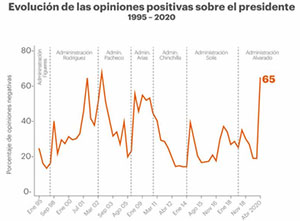 In the midst of the Coronavirus crisis there was one bright spot, at least for the President of the Republic. According to the University of Costa Rica's polling survey (CEIP-ECP - we don't have enough space to unravel that acronym), President Alvarado's approval rating skyrocketed in the last two months to 65%. That equals the highest rating for a president in the last seven presidents with the exception of the very early administration of Pacheco some 18 years ago.
In the midst of the Coronavirus crisis there was one bright spot, at least for the President of the Republic. According to the University of Costa Rica's polling survey (CEIP-ECP - we don't have enough space to unravel that acronym), President Alvarado's approval rating skyrocketed in the last two months to 65%. That equals the highest rating for a president in the last seven presidents with the exception of the very early administration of Pacheco some 18 years ago.
The chart at left shows president approval level for the last 25 years and covers seven presidents. Remember that the Costa Rican constitution limits presidents to one term after which they may sit out one term and then run again for a second term, so most run for only one term. Alvarado's handling of the crisis with early and complete closing of the borders and strict distancing policies is credited with this result.
Like elsewhere the problem now becomes reopening and re-establishing growth in the economy. Can you hold your popularity during that process Señor Presidente?
New President of Legislative Assembly
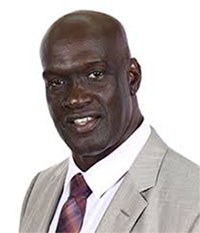 |
| Eduardo Cruickshank |
While President Carlos Alvarado was enjoying his newfound popularity, another president was being inaugurated. The Legislative Assembly, the Costa Rican equivalent of the U.S. Congress, elected their own president, one Eduardo Newton Cruickshank Smith, a lawyer by education and and associate pastor of a church (Portadores de su Gloria or Bearers of His Glory) in his home town of Limón on the Caribbean Coast.
One press report described him as: "The Pastor Passionate About Politics". (I like a man who knows how to write a tag line)
One might think of the President of the Legislature as equivalent to the Speaker of the House in the States but for the fact there is only one legislative body here so he's speaker of everything legislative. Eduardo Cruickshank becomes the first man of African descent to occupy that office and now becomes the speaker for the unicameral national legislature consisting of 57 deputies.
Congratulations, and ¡Exito! (success) amigo.
Four Men Arrested For Being on Beach
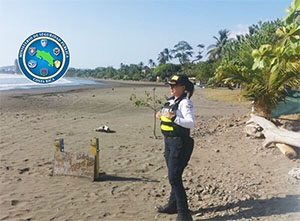 |
| Don't Mess With the Beach Fuzz |
Part of the lock-down in Costa Rica has been the closing of all beaches (GG often breaks into tears at this realization). A few months ago the idea that someone would be arrested for just being on the beach would be laughable; but not now.
On April 28 four men were "detained" (that's Costa Rica speak for arrested) on a Caribbean beach near Limón. Two of these men had been warned twice, one and two weeks before, that they should not be on the beach. So this was the third time they had been in trouble with the local gendarmes for violating the quarantine order.
They were arraigned by a local magistrate and charged with "disobedience to authority" (I guess that's the Costa Rican version of "unlawful trespass"). All four men elected to accept the charges. One man got a one-year jail sentence - suspended, and three were each fined ₡150,000 (about $260) to be paid by the purchase of school supplies. (That'll learn 'em)
Methinks GG will be avoiding the beaches a little longer.
Dealing With Border Leaks
Although Costa Rica took early action to close its borders, there is still a significant problem of Coronavirus infections caused by illegal immigration and repatriation efforts.
Recently some 13 detainees at the National Migrant Retention center in Heredia tested positive for COVID-19. This facility, one of several like it in the country, was immediately isolated and treatment of the infected people begun.
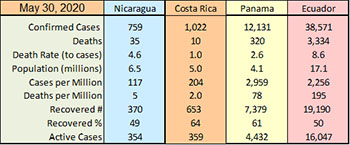 In another example, 40 Costa Ricans were recently repatriated from being stranded in Ecuador. Over half of these (26) had waited several weeks in Guayaquil, the epicenter of the disease for Ecuador, until the repatriation flight could be arranged. When they were tested on arrival at the Costa Rican airport four of them were found to be infected and were immediately isolated and treated. All others were assigned to a 14-day self-quarantine. There have been a total of 13 repatriation flights that have landed at Juan Santamaria Airport since the shutdown began and they have yielded a total of 15 new COVID positives.
In another example, 40 Costa Ricans were recently repatriated from being stranded in Ecuador. Over half of these (26) had waited several weeks in Guayaquil, the epicenter of the disease for Ecuador, until the repatriation flight could be arranged. When they were tested on arrival at the Costa Rican airport four of them were found to be infected and were immediately isolated and treated. All others were assigned to a 14-day self-quarantine. There have been a total of 13 repatriation flights that have landed at Juan Santamaria Airport since the shutdown began and they have yielded a total of 15 new COVID positives.
Costa Rica has added a considerable number of new patrols, both air reconnaissance and land patrols, along the northern border with Nicaragua but Illegal immigration continues to happen despite this increased effort. There is concern for this source of possible infection particularly when the neighboring country (in this case Nicaragua) pursues a policy of ignoring the disease (their official numbers in the table above are not believed by anyone).
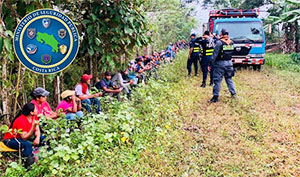 In this regard, Costa Rica recently intercepted a large cattle truck containing some 69 Nicaraguans trying to cross over the border near Los Chiles (North Central CR) at a largely unattended area often labeled a "blind spot". These poor people were stuffed into a small, Nicaragua-registered cattle truck which hoped to evade the patrols (see photo left). No information was released on the state of health of these people but I suspect they will all be tested for COVID.
In this regard, Costa Rica recently intercepted a large cattle truck containing some 69 Nicaraguans trying to cross over the border near Los Chiles (North Central CR) at a largely unattended area often labeled a "blind spot". These poor people were stuffed into a small, Nicaragua-registered cattle truck which hoped to evade the patrols (see photo left). No information was released on the state of health of these people but I suspect they will all be tested for COVID.
Costa Rica has now (I believe this was started on or around May 11) instituted COVID-19 testing on all truckers requesting passage through our borders. Since the test-every-trucker policy was instituted there have been 26 positive results on border crossings including 23 in one 10-day period. A positive test results in the approval of the crossing being denied.
 |
| Trucks Backed Up At Peñas Blancas Border. The Line Reached Some 20 km Long At One Point |
On May 11 a man driving a truck, who had spent 15 hours driving through Nicaragua, got off the truck on the Nicaraguan side of the border, walked to the Costa Rican side of the border leaving his truck behind and collapsed. He was taken to the hospital and later tested positive for the Coronavirus.
By May 20 confusion reigned at the main Nicaragua/Costa Rica border with some 1,600 trucks held up for testing. Innovative solutions were being sought and employed such as police armed escorts of truck caravans through Costa Rica. Also a previous discarded idea of running a ferry from El Salvador to Costa Rica, thereby bypassing Nicaragua, was having a fresh look.
In a separate case, a Costa Rican man from Los Chiles was recently given a sentence of six and a half years in prison for aiding two Nicaraguans in their illegal entry into Costa Rica during the emergency shutdown.
So there are many ways the virus can pervade borders even when they are closed.
UPDATE (May 21): In an apparent tit-for-tat action to Costa Rica's test-every-trucker policy, the Nicaraguan government on May 18 closed the Nicaraguan side of the Peñas Blancas border crossing at the northwest corner of Costa Rica. Well, that might be a good thing for Costa Rica in the long run as it lowers potential risk of cross-border COVID transfers but... does it. The day that the closure report hit the press another report suggested that many Nicaraguans are believing the virus may spread out of control there and the resulting chaos could make that border indefensible. Stay tuned.
On May 21 Costa Rica and Panama announced a joint agreement allowing trucks controlled entry to Costa Rica. Provisions of the agreement include 1) travel only to redetermined and government approved warehouses, 2) "strict health control and sufficient time to unload, load and rest, although they have a maximum period to stay in Costa Rica" and 3) strict controls on leaving, possibly including traveling in police supervised caravans back to the border.
One has to wonder how much all of these border leakages might have contributed to the recent up-tick in new cases here (see below).
Church Cancels Romeria
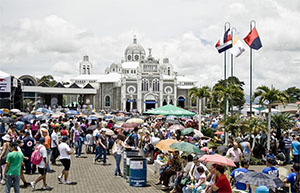 |
| The National Cathedral in Cartago |
Without doubt the largest gathering of people in Costa Rica occurs once a year, culminating at the Basílica de Nuestra Señora de los Ángeles in Cartago. (Our Lady of the Angels Basilica)
Every August 2nd, over one million people from all parts of Costa Rica make a pilgrimage to the church that contains a small statue that is believed to have been the center of a miracle. The miracle surrounding the small black statue is known as La Negrita and is revered to have been the work of the Virgin of Los Angeles. She is the patron saint of Costa Rica and her small statue resides at the cathedral. The march itself is known as the "Romeria".
To read more about this event, go here: La Negrita.
The Catholic Church in Costa Rica recently announced that the Romeria this year has been canceled because of the risk associated with the Coronavirus. This will be only the second time in 385 years that the pilgrimage has been canceled (yes, the story goes back to 1635), the other time being in 2009; that one because of the H1N1 swine flu.
New Costa Rican Holiday
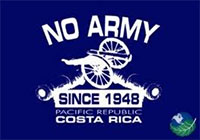 Current President Carlos Alvarado recently officiated at a law signing ceremony making December 1 a new holiday; Army Abolition Day. It celebrates the day in 1948, after the conclusion of the civil war, when the constitution of the Second Republic was approved and the Army was abolished. On that day, then President José Figueres Ferrer symbolized the act by smashing down part of the wall with a sledge hammer at the military barracks in San José.
Current President Carlos Alvarado recently officiated at a law signing ceremony making December 1 a new holiday; Army Abolition Day. It celebrates the day in 1948, after the conclusion of the civil war, when the constitution of the Second Republic was approved and the Army was abolished. On that day, then President José Figueres Ferrer symbolized the act by smashing down part of the wall with a sledge hammer at the military barracks in San José.
The new holiday will replace October 12's Día de las Culturas or Cultures Day which celebrated the day when Christopher Columbus arrived in the new world. (Poor Chris gets such short shrift in so many corners these days) That keeps the number of mandatory paid vacation days at 10; in addition there is one non-paid day (Virgin of Los Angeles - see Romeria article above) and public employees get three extra paid holidays (Monday, Tuesday and Wednesday of Semana Santa or Holy Week)
¡Pura Vida!
TOP
Economic Drumbeat
(Costa Rica Business and Economic Happenings)
Growing Hemp Suggested for Post-COVID Economic Recovery
Costa Rica, like many countries, is considering ways to regenerate the economy in a post-COVID era. One crop not only being considered but currently proposed in the legislature is the growing of cannabis Hemp, a plant of reportedly very low concentrations of THC, the active ingredient in cannabis marijuana.
Because Hemp is a cousin to marijuana there has been reluctance in the past to approve growing it. In 2018, the Costa Rican Supreme Court decriminalized possession and cultivation of personal quantities of marijuana. Selling marijuana, as well as large-scale possession and/or cultivation remain crimes punishable by imprisonment. Approval of Medical Marijuana is being considered at this time in the legislature.
 Proponents point out the many, many uses of hemp shown in the chart to the right above. "Its seeds and flowers are used in health foods, organic body care, and other nutraceuticals. The fibers and stalks are used in hemp clothing, construction materials, paper, biofuel, plastic composites, and more." Hemp is also an attractive rotation crop for farmers, preventing erosion and enriching the soil in certain nutrients.
Proponents point out the many, many uses of hemp shown in the chart to the right above. "Its seeds and flowers are used in health foods, organic body care, and other nutraceuticals. The fibers and stalks are used in hemp clothing, construction materials, paper, biofuel, plastic composites, and more." Hemp is also an attractive rotation crop for farmers, preventing erosion and enriching the soil in certain nutrients.
More on this project to be revealed later.
COVID Changes Inflation to Deflation
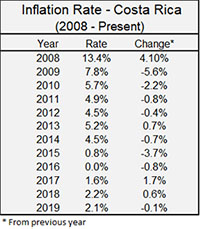 One would not expect pressure to increase prices during a period when production and demand are artificially suppressed, like now. Recent reports on inflation rate confirm that, and although relatively minor, an actual deflation rate was achieved in the early months of this year.
One would not expect pressure to increase prices during a period when production and demand are artificially suppressed, like now. Recent reports on inflation rate confirm that, and although relatively minor, an actual deflation rate was achieved in the early months of this year.
The table to the right gives the annual inflation rates for Ticoland from 2008 to 2019. The inflation rates in the 2007-8 period were substantial - over 20% total for the two years (those being the first two years GG resided here, but I swear I had nothing to do with those increases). The years from 2015 to 2019 have shown a very nice stabilization of inflation (average of 1.3% per year).
The government reported recently that inflation for March-April was a negative half per cent making year-to-date figures virtually unchanged at -0.1%. Reestablishing economic performance of course is the now the question of highest interest but let's hope this little ray of positive light will continue.
Roche Pharmaceutical to Double CR Operations
GG hopes the following report is a sign that we can get back to what this section of the Golden Gringo Chronicles was designed to provide to GGC readers - reports of a growing economy in Costa Rica.
 Roche is a large (+$60 billion with nearly 20% profit margin) Swiss Pharmaceutical company that has support for its Americas operation based in Escazu Village near San Jose. This year they plan to add another 370 employees bringing their total here to 700. The expansion in Services & Solutions will add a Human Resources department and later Finance and Procurement.
Roche is a large (+$60 billion with nearly 20% profit margin) Swiss Pharmaceutical company that has support for its Americas operation based in Escazu Village near San Jose. This year they plan to add another 370 employees bringing their total here to 700. The expansion in Services & Solutions will add a Human Resources department and later Finance and Procurement.
Said General Manager - Americas Héctor Feliú: "The new positions will help us continue providing world-class support for customers throughout the Americas in a variety of languages including English, Spanish, Portuguese, and French. We have found exceptional talent in Costa Rica and these new positions will strengthen our ability to continue fulfilling our commitment to the organization”.
Soyez le bienvenue mes amis y bien venidos amigos (can't help you with the Portuguese).
CR Company Gets Ford Contract
 Readers have probably heard and seen reports of the major effort by the U.S. Government and major manufacturers to convert some manufacturing facilities to the production of ventilators for COVID-19 patients, used particularly for those in the most critical condition. Ford Motor Company was one of those manufacturers who undertook the conversion of some of their plant. In turn they recently awarded a sub-contact to produce 100,000 pressure switches to Microtechnologies of Costa Rica.
Readers have probably heard and seen reports of the major effort by the U.S. Government and major manufacturers to convert some manufacturing facilities to the production of ventilators for COVID-19 patients, used particularly for those in the most critical condition. Ford Motor Company was one of those manufacturers who undertook the conversion of some of their plant. In turn they recently awarded a sub-contact to produce 100,000 pressure switches to Microtechnologies of Costa Rica.
 |
| The Plan in El Coyol |
Microtechnologies S.A. is based in El Coyol (about 15 minutes by car west of Juan Santamaria Airport) where they will produce the pressure switches. Microtechnologies is a small (less than $20 million annual sales), wholly-owned Costa Rican company. The company has been operating in Costa Rica for 22 years and has dedicated a team of some 350 Costa Ricans to producing the switches.
 |
| The Switch |
The switch (photo left) is an electro-mechanical diaphragm device that will precisely regulate the compressed air pressure in the ventilator to assure the patient is getting exactly what he ventilator was set for; obviously a critical function.
A portion of the contact has already been produced and they expect to complete the total order for 100,000 in the next few weeks. (now that's a new definition of Tico Time, amigos).
¡Exito!
TOP
Latin America Updates
(Major Events In Neighboring Countries)
Ecuador
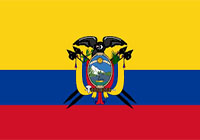 Forty Ticos on tour of Ecuador were recently caught there in the transportation freeze caused by the Coronavirus; they were stranded for over a month. Of these, some 26 had been staying in the city of Guayaquil which happens to be the epicenter for the disease in Ecuador (stats as of May 30 for Ecuador were: cases=38,571, deaths=3,334, recovered=19,190). The flying time from Quito to San José is only about two hours but the group of 26 from Quayaquil had to endure an eight hour bus ride from Quayaquil to the capital city airport in Quito before the flight.
Forty Ticos on tour of Ecuador were recently caught there in the transportation freeze caused by the Coronavirus; they were stranded for over a month. Of these, some 26 had been staying in the city of Guayaquil which happens to be the epicenter for the disease in Ecuador (stats as of May 30 for Ecuador were: cases=38,571, deaths=3,334, recovered=19,190). The flying time from Quito to San José is only about two hours but the group of 26 from Quayaquil had to endure an eight hour bus ride from Quayaquil to the capital city airport in Quito before the flight.
The forty arrived home at Juan Santamaria airport in San José on April 19. All forty were given strict 14-day quarantine orders and each was tested for COVID; four have since gotten positive results and are being treated.
The COVID situation in Ecuador is considerably more urgent than in Costa Rica (as of 30 May in Costa Rica, to wit, cases here=1,022, deaths=10, recovered=653). The group from Ecuador was very happy to be home: "It is a joy to be back in Costa Rica.” said one Tico.
El Salvador
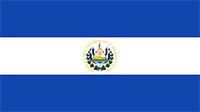 We mentioned last month how the new president of El Salvador, Nayib Bukele, was elected less than a year ago on the platform of reducing his country's historically inherent and abundant violence, particularly among gangs. As a result, El Salvador often leads the Americas and World statistics in murder and violent behavior. In 2019 the murder rate in El Salvador was 52.0/100,000 while in Costa Rica it was 11.3 (U.S. - 5.0, Canada - 1.8).
We mentioned last month how the new president of El Salvador, Nayib Bukele, was elected less than a year ago on the platform of reducing his country's historically inherent and abundant violence, particularly among gangs. As a result, El Salvador often leads the Americas and World statistics in murder and violent behavior. In 2019 the murder rate in El Salvador was 52.0/100,000 while in Costa Rica it was 11.3 (U.S. - 5.0, Canada - 1.8).
This past month saw some records in this regard with one weekend in which there were 53 gang-related murders. El Salvador is only about 30% larger than Costa Rica in population (6.5 million vs 5.0 million). Reacting to this new level of violence, President Bukele issued the following order: “The police and armed forces must prioritize safeguarding their lives, those of their companions and of honest citizens. The use of lethal force is authorized in self-defense or in defense of the lives of Salvadorans”.
The government also ordered the remixing of incarcerated gang members so that cells did not contain only the same gang. (One has to wonder if there wasn't a little "Let 'em take each other out attitude behind this one") There are almost 13,000 gang members incarcerated in El Salvador.
Nicaragua
 COVID-19 Status. The Chronicles noted last month the strange position of the government of Nicaragua towards the COVID-19 pandemic; basically, they've ignored it. They have taken no action to control their borders from encroachment of the disease, no rules for social interaction and have no testing regimen nor treatment protocol for those infected. Basically the policy is if you don't test for it and don't see it, it doesn't exist. If you get it and die, you've suffered from "atypical pneumonia".
COVID-19 Status. The Chronicles noted last month the strange position of the government of Nicaragua towards the COVID-19 pandemic; basically, they've ignored it. They have taken no action to control their borders from encroachment of the disease, no rules for social interaction and have no testing regimen nor treatment protocol for those infected. Basically the policy is if you don't test for it and don't see it, it doesn't exist. If you get it and die, you've suffered from "atypical pneumonia".
As of May 18 Nicaragua had reported only 25 cases of COVID-19 with 8 deaths, a death rate (32%) which by the way is much higher than their neighbors (Panama - 2.9%, Costa Rica - 1.1%, Honduras - 5.4%, El Salvador - 1.9% and Guatemala - 1.9%). Another report about a week later went up to: cases-254, deaths 17 and yet another report on May 30 listed total cases at 759 with 35 deaths. The suspicion is that the government's counts are totally unreliable and unofficial estimates from civil organizations that should be in the know currently put estimates of cases in excess of from 2,000 to 3,000 and deaths over 400.
On May 20 the U.S. Embassy in Nicaragua authorized a repatriation flight from Managua to Miami on which 150 Americans left Nicaragua for home. The flight was run by Eastern Airlines. Really? - I thought Eastern, which I used to fly in the '60s and '70s, as a company was dead many years ago but evidently they're making a comeback - an inauspicious restart for Eddie Rickenbacker's old company. Eddie was the first U.S. ace in WW I (no, amigos, I wasn't there personally).
Last month La Prensa, the most widely circulated newspaper in Nicaragua and no friend of the current regime having been nearly put out of business by them, reported that Minsa (the Ministry of Health) had given orders to hospitals to diagnose and record COVID-19 cases as “community-acquired pneumonia” The paper also claimed they had evidence that several workers at the Managua International Airport had come down with the disease and that at least two of them had died of it. The paper also claimed that expired patients were being transported out of the hospital directly to the cemetery by the back door using an unmarked van. Another report had it that a family left their father one night in serious condition in the hospital and when they returned the next morning he had already been buried.
Sensationalism, unproven stories? Don't know; more to be revealed, eventually.
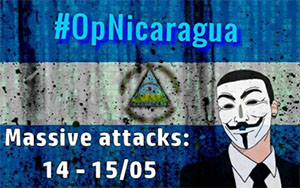 #opnicaragua. As if dealing with the COVID-19 virus wasn't enough, at least one internet based group has emerged to do trouble to various government agencies and critical businesses around the world, including those in Nicaragua. The group is called "Anonymous" and is described as "...a decentralized international hacktivist (sic) group that is widely known for its various cyber attacks against several governments, government institutions and government agencies, corporations, and the Church of Scientology." To see more of what these cyber turkeys are all about check out this CBS News Report: https://www.youtube.com/watch?v=iknsdj34LIM.
#opnicaragua. As if dealing with the COVID-19 virus wasn't enough, at least one internet based group has emerged to do trouble to various government agencies and critical businesses around the world, including those in Nicaragua. The group is called "Anonymous" and is described as "...a decentralized international hacktivist (sic) group that is widely known for its various cyber attacks against several governments, government institutions and government agencies, corporations, and the Church of Scientology." To see more of what these cyber turkeys are all about check out this CBS News Report: https://www.youtube.com/watch?v=iknsdj34LIM.
Anonymous decided to institute a cyber attack in Nicaragua on May 14-15 targeting government agencies and banks. They flood Twitter with there messages and have labeled their Nicaraguan operations as #opnicaragua, claiming as their objective some 60 targets, including banks, state ministries, government media and even the opposition Civic Alliance for Justice and Democracy. Since then there have been sporadic reports of the group hacking into various government systems but definitive results have not yet been reported.
¡Solo Bueno!
TOP
Rumble and Weather Talk
(Shaky Happenings and Weather Observations On or About the Pacific Rim)
Rumble Talk
Fortunately we don't have much rumble to talk about. Every week or so one feels or hears about a 5+R tremor but at this time in Costa Rica the ones lately seem to be more on the Caribbean shore side of the country. But nothing of serious damage potential. Good.
Weather
Not much here to talk about either. We find ourselves still in the changeover season from dry to rainy. That means it's not unusual to have substantial showers at night but still have very hot days without significant clouds.
So it goes in the ITCZ (International Tropical Convergent Zone).
¡Pura Vida!
Check Out Recent Earthquakes Around the World Posted by the U.S. Geodetic Survey: Recent Quakes |
TOP
Search the Golden Gringo Chronicles Archives for Topics That Interest You
You can use our Archives to search for anything that has been written in more than 260 feature articles of the Golden Gringo Chronicles plus find Broken News items and ROMEO restaurant reviews. Enter your topic or item to search in the Google Search Routine below and follow the links offered from the search results. Suggestion: Enter only a simple, precise and unique as possible keyword or
two in order to narrow the number of references retrieved:
Golden Gringo Chronicles - Enter Search Here
Readers: Our publication is open to suggestions regarding future articles
and will accept pieces written by others but we reserve the right to decline
anything that the
editorial staff (that's GG) thinks is inappropriate for this format. Send proposals, comments, suggestions, ideas, meaningless statements and jocular observations concerning the Chronicles to GG here: gg@goldengringo.com.
Viruses Are Us
(Picking Your Favorite Pandemic - Part 2)
Last month the Chronicles began a summary of the top 20 pandemics that have troubled humankind since history began. We highlighted ten epidemics that started as early as 3,000 BC up to and including a plague that killed as many as 100,000 in Marseilles, France in 1720-23. In addition to those particulars, there were at least ten more pandemics since 1723 which are highlighted here:
11. Russian plague 1770-1772:
 |
| Catherine, Empress of Russia |
The fear and terror of the people quarantined in Moscow resulted in riots throughout the city and the murder of the presiding Archbishop Ambrosius, who was encouraging crowds not to gather for worship.
The empress of Russia, Catherine II (also called Catherine the Great), was so desperate to contain the plague and restore public order that she issued a hasty decree ordering that all factories be removed from Moscow (just exactly how did that help Cat?). By the time the plague ended, as many as 100,000 people may have died. Even after the plague ended, Catherine struggled to restore order. Catherine ruled until 1796.
12. Philadelphia Yellow Fever Epidemic 1793:
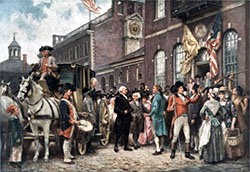 |
Washington Arrives
at the Philadelphia Capital |
This happened when Philadelphia was still the capital of the United States. Yellow Fever, carried by mosquitoes, hit the city hard during the very warm and humid summer of 1793, only six years after the federal government had been established.
One interesting but horrific sidelight to this one was that there was a general belief that slaves were immune to the disease so officials and abolitionists "called for people of African origin to be recruited to nurse the sick". The onset of winter and the disappearance of mosquitoes stopped the disease but not until over 5,000 had been killed or about 10% of the city's population (Philadelphia's current population is 1.6 million).
13. Flu Pandemic 1889-1890:
The modern industrial age was in full swing and new transport and travel links enhanced the spread of this virus. Within "... a few months, the disease spanned the globe, killing 1 million people. It took just five weeks for the epidemic to reach peak mortality."
It all started in Russia. The virus spread rapidly throughout St. Petersburg before it quickly made its way throughout Europe and then the rest of the world, long before air travel became available.
14. American Polio Epidemic 1916:
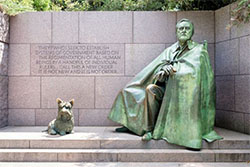 |
| Roosevelt Memorial in Washington (FDR is Seated in Wheel Chair) |
Probably the most famous victim of this virus was President Franklin Roosevelt who contracted it in 1921 and would live with it until his death in 1945. The disease would sometimes cause lifelong paralysis and breathing difficulties; it affected millions of children until the Salk Vaccine was invented in 1954.
GG was 11 years old in 1954 and I can still remember a family near ours that had a young boy in an iron lung to help him breath. Even after the vaccine was developed, occasional outbreaks were still recorded, the last case in the U.S. being in 1979.
15. Spanish Flu 1918-1920:
This was one of the most pervasive and pernicious of them all. It effected some 500,000,000 people worldwide or fully one third of the population of the globe at the time. The spread and lethality of the disease were increased because of cramped and close conditions in many parts of the world brought on by World War I. Of the 500 million infected, somewhere between 50 and 100 million (!) died of this pandemic. The disease was eventually named the H1N1 virus and reappeared later (see #18 below).
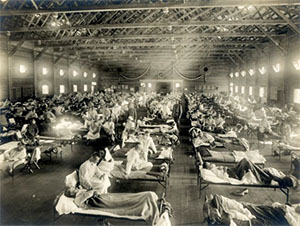 |
| Spanish Flu Emergency Ward Cerca 1920 |
"Initial symptoms of the illness included a sore head and tiredness, followed by a dry, hacking cough; a loss of appetite; stomach problems; and then, on the second day, excessive sweating. Next, the illness could affect the respiratory organs, and pneumonia could develop. Humphries explains that pneumonia, or other respiratory complications brought about by the flu, were often the main causes of death. This explains why it is difficult to determine exact numbers killed by the flu, as the listed cause of death was often something other than the flu." (Sounds a lot like COVID-19, eh?)
While this virus was called the Spanish Flu it did not originate in Spain. Recent research points to China as the source, first spreading by itinerant Chinese workers in Madrid and then through the rest of Europe, eventually permeating almost all areas of the world.
16. Asian Flu: 1957-1958:
This one was also believed to have come from China. It was determined to be a blend of avian flu viruses. It was first reported in Singapore in February 1957 and by April of that year had been detected in Hong Kong. During the summer of 1957 it reached the coastal cities in the United States. By the time the Asian Flu wore itself out it had claimed 1.1 million deaths worldwide and 116,000 in the United States.
17. AIDS Pandemic and Epidemic 1981- Present Day:
AIDS (Acquired Immune Deficiency Syndrome) was and is second only to the Spanish Flu pandemic (#15 above) in the fatalities has accounted for over 35 million deaths around the world. The virus that causes AIDS is called HIV (Human Immunodeficiency Virus) and is believed to have been first transferred from a chimpanzee to humans in Africa in the 1920's. By the end of the 20th century (1980's) the disease had reached pandemic proportions worldwide.
Two-thirds of the remaining people who currently have HIV, as many as forty million, are believed to now live in sub-Saharan Africa. Medical treatments for AIDS were developed in the 1990's that allow sufferers a normal lifespan with regular treatment. In recent months a couple of cures have been reported that hold out hope for an eventual elimination of the disease but it still is a viable pandemic in certain parts of the world.
18. H1N1 Swine Flu Pandemic 2009-2010:
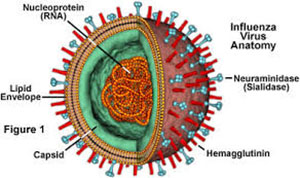 |
| H1N1 Virus - Looks a Lot Like COVID from the Outside But That's Why I'm Not a Virologist |
The 2009 Swine Flu Epidemic was essentially a replay of the H1N1 virus that first occurred as the horrendous Spanish Flu Pandemic in 1918. It is believed to have originated in early 2009 in Mexico before spreading to 1.4 billion people around the globe and causing between 151,700 and 575,400 deaths.
This particular strain of the virus was unusual in one respect in that it effected younger people more than a typical virus such as COVID-19; 80% of the fatalities in the Swine Flu were under 65 years of age. This is believed to be so because older people may have built up more immune tolerance to earlier versions of H1N1. Part of the current standard "Flu Vaccine" that medical organizations suggest you take every year is believed to include a component to treat H1N1.
19. West African Ebola Epidemic 2014-2016:
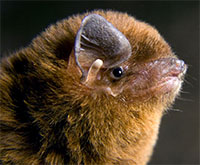 |
| Ebola Bat |
This one is believed to have come from bats and records say that the first known cases of Ebola were in the Sudan and the Democratic Republic of Congo in 1976. The first case to be reported was in Guinea in December 2013 and then, between 2014 and 2016, it savaged the small west African countries of Guinea, Liberia and Sierra Leone generating 28,600 reported cases and 11,325 deaths. A smaller number of cases occurred in Nigeria, Mali, Senegal, the United States and Europe.
The efforts at finding a vaccine are continuing but at this time there is no known cure for Ebola.
20. Zika Virus Epidemic 2015-Present:
Zika, like Dengue, is a virus borne by mosquitoes (Aedes type) who tend to be most prolific in hot, humid rainforest type places like Central America, South America and a slew of countries and areas that run relatively close to the equator. Spraying insecticides to control mosquitoes still is one of the primary methods to control these viruses while research into vaccines and other medicinal treatments continues. Zika is not as harmful to young people as it is to older adults but infection of unborn infants in the womb can result in birth defects.
___ ___ ___
So the onset of COVID-19, while still very serious and deadly, should not be a surprise to humankind; we have experienced these afflictions many times and the data shows that we have lost over 110,000,000 people to virus pandemics just since 1900. And that is despite herculean efforts to develop anti-virus treatments and cures.
The fatalities number for COVID-19 puts the disease third only to the Spanish Flu and AIDS in the last 120 years of experience with these things. It also suggests that, without the severe actions taken in the last few months, the situation could have been much worse.
Perhaps this is what happens when we crowd nearly eight billion (8,000,000,000) people into a planet that 500 years ago, when the Spanish arrived in the Americas, had only 440 million (440,000,000). That's an increase of over 1,700% in five centuries. Is this how nature fights back?
Wouldn't it be wonderful if the health industry could come up with a universal vaccine for viruses?
¿Que es Eso? Department
(What is That?)
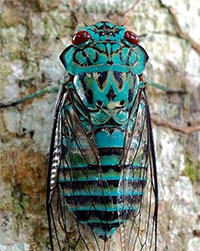
Now That's One Pretty Fly!
Or is it?
Answer in
What's-in-a-Word
section below.
¡Pura Vida!
TOP
 The space below was intended for a GGU article (Golden Gringo University - a lower institution of learning) about obtaining naturalized citizenship in Costa Rica, a process GG has been pursuing for some time. I've gotten approval (three times now) and was awaiting an appointment for a photo to get a new cédula by the appropriate government bureau but the onset of the Coronavirus shortened staff and operations at government offices. The national emergency has slowed the process of getting new approvals from government agencies on just about anything and everything.
The space below was intended for a GGU article (Golden Gringo University - a lower institution of learning) about obtaining naturalized citizenship in Costa Rica, a process GG has been pursuing for some time. I've gotten approval (three times now) and was awaiting an appointment for a photo to get a new cédula by the appropriate government bureau but the onset of the Coronavirus shortened staff and operations at government offices. The national emergency has slowed the process of getting new approvals from government agencies on just about anything and everything.
I offer the following story in place of my intented story and hope to conclude the GGU article on citizenship next month.
Honoring Grandpa
(Customs of the Jícaro Valley Amerindians)
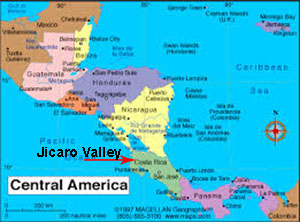 The isthmus, now known as Central America, consists of seven countries, alphabetically: Belize, Costa Rica, El Salvador, Guatemala, Honduras, Nicaragua and Panama (or, going north to south: Belize, Guatemala, Honduras, El Salvador, Nicaragua, Costa Rica and Panama). Together they represent a total population of just under 50 million people.
The isthmus, now known as Central America, consists of seven countries, alphabetically: Belize, Costa Rica, El Salvador, Guatemala, Honduras, Nicaragua and Panama (or, going north to south: Belize, Guatemala, Honduras, El Salvador, Nicaragua, Costa Rica and Panama). Together they represent a total population of just under 50 million people.
Central America, in a geological and historical sense, is still in its infancy when one considers that estimates place the isthmus being formed only 2.8 million years ago (yuk,yuk), while the first upright-walking human on earth appeared 20-30 million years ago and the formation of the earth itself was around 4,540 million years ago (that's 4.5 billion for those of you from Rio Linda).
It was only about 14,000 years ago that our forbearers began their settling of the Americas (i.e., they became "Paleo-Indians") by crossing the Beringia land bridge between Russia and Alaska much of which has since dissolved into the Bering Sea. Within a short time, i.e., several hundred to a couple of thousand years, the Paleo-Indians had succeeded in migrating all the way down into many parts of South America. The area now called Costa Rica, being central on the North American - South American isthmus and land bridge, often became a stopping point and melting pot for various Amerindians who migrated south from North America or north from South America and decided to stop here (as they used to say about the American West: "they settled here because that's where the wagon wheel fell off").
These migrations and new settlements set the stage where many tribes developed different customs and heritage all along the American continent.
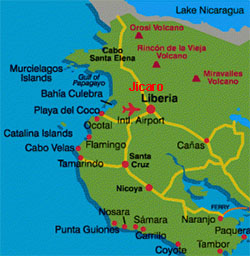 The science and practice of archaeology has slowly uncovered many different examples of Amerindian culture all over the Americas. One of the more interesting ones found in Costa Rica is the archaeological remnants of a people that populated an area near the modern town of Liberia in the northwestern corner of Costa Rica. The area is less than 90 km south of the Nicaragua border and dead center on the migratory route south.
The science and practice of archaeology has slowly uncovered many different examples of Amerindian culture all over the Americas. One of the more interesting ones found in Costa Rica is the archaeological remnants of a people that populated an area near the modern town of Liberia in the northwestern corner of Costa Rica. The area is less than 90 km south of the Nicaragua border and dead center on the migratory route south.
Known as the Jícaro valley it is buttressed by the Gulf of Papagayo and Bahia Culebra (Culebra Bay) on the Pacific Coast. The area is possibly named after the Amerindians who lived there; or maybe it's the other way around and the Amerindians were given the name because that's where they lived. Whatever.
The Jícaros are believed to have been a splinter group of a Mexican people who had tired of "political pressures". Mayan political pressure could be severe, up to and including ritual executions to please the gods. So the Jícaros are believed to be migrants and descendants of Mexico that settled in Guanacaste during the period from 800 to 1300 AD. Some of their more modern descendants are known as Chorotegas. Of course, many of these practices would change drastically after the Colombian period began in the early 1500's.
The Jícaro is also a tree. Aha! maybe the valley is named after the tree; elsewhere the tree goes by the name of the Mexican Calabash. The tree bears fruit in an unusual way; it kind of pops out of the trunk of the tree (photo-right). The fruit is in the breadfruit family and the seeds are reportedly sweet when made into a drink. (Gotta try it, gotta try 'em all; GG spent his first two years in Costa Rica discovering a new fruit each month at the local outdoor market - never had a bad one and I'm sure I missed a few, like the Jícaro)
The globes of the Jícaro fruit can be tough and hard when dried out. After the fruit and seeds have been hollowed out they are often used to make artisenal products like the bracelets shown in the middle photo to the right, or even fashioned into maracas (lower photo). Costa Rica is a land of exceptional biodiversity; we never throw away a natural product that can be converted into something useful (or celebratory), like the using of rosewood to make a marimba.
Now back to the local Jícaro Amerindians. Examination of the relics found at the Jícaro archaeological sites indicate some unusual practices. It was common in much of Mesoamerica in the old days for people, particularly warriors, to be buried with their weapons, their personal effects and anything else they were deemed to be fond of (sometimes even live family members).
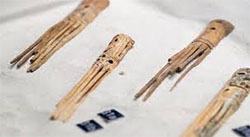 |
| Combs Made of Ancestors Bones |
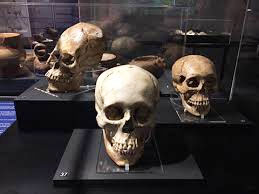 |
| Examples of Cranial Modification |
 |
| Beauty is as Beauty Does |
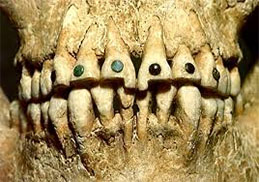 |
| Ain't I Beautiful? |
But what the archaeologists found with the Jícaros was many examples of the bones of ancestors being used as decorations or personal items. These bones were made into bracelets, combs and other objects that could be used on a daily basis. In this way, the Jícaros believed they were paying homage to their ancestors by decorating themselves with their bones.
Another practice employed by the Jícaros was that of cranial modification. Check out the center photo to the left which is a display of skulls found in that area. In particular, look at the one far left which is very evident from its shape that the skull has been elongated in some manner.
Said one archaeologist: "Artificial cranial modification was a practice performed on very young children. Some slabs were tied to their heads to elongate the skull for an aesthetic effect, while the dental filing was common among adults of Mesoamerican descent, also for aesthetic reasons and as a status symbol, or just to look different."
The dental filing he spoke of was the practice of filing down the side and/or tips of teeth to give them a unique appearance. Often the teeth would also be drilled into and a semi-precious stone like jade or pearl inserted (check out photo of the skull of a rich man lower left). The more elaborate these decorations the more likely you were rich or important.
The multiple heads photo to the left made me think of the History Channel (this is what happens when you have too much time in quarantine and decide not to watch more of the endless violent drivel found on the boob tube these days). I could hear the History Channel announcer saying: "Could it be that the Amerindians and other peoples who've practiced this around the globe were simply trying to imitate their extraterrestrial visitors? - Ancient Astronaut Theorists say Yes!" (Well, come on, it's better than endless re-runs of CSI and Rambo)
Some of these relics have been organized into an exposition at the National Museum in San José, a place that, if you haven't already visited it, definitely should be on your agenda. The last time I was there I was very much impressed with the multi-level entrance to the museum and exposition section that also serves as a home to a wide variety of butterflies fluttering around. Kool and impressive.
___ ___ ___
P.S. If you want to read more stories about the Pre-Columbian Costa Ricans, their lifestyle and their legends, you may want to read a couple of books by GG listed on the GGC Bookshelf below: Mariposa, A Love Story of Costa Rica and Las Esferas, The Mystery Spheres of Costa Rica. (Sorry amigos, couldn't resist the chance to plug my books)
¡Pura Vida!
TOP
Health Stuff
| Note: The information given in this section is offered as news information only and does not indicate GGC confirmation or denial of the accuracy of the treatment or a recommendation to pursue it, nor can we or do we guarantee the efficacy of the results nor validity of the conclusions proffered.
(How's that for a disclaimer amigos?) |
Costa Rica Still Showing Better Numbers for the Pandemic
Press reports have noted that Costa Rica was the first country in Latin America to have reported a case of COVID-19 (March 6). It was pointed out last month that the Costa Rican response to the Coronavirus here, i.e., quick border closure, business shutdowns and strict personal quarantines, may have resulted in low numbers for total infected, death rate and a higher percentage of recoveries. This is true both in total numbers and population adjusted rates. Not bragging here; just presenting the facts.
The report last month also noted one difference in treatment protocol here, notably the use of Hydroxychloroquine early in the stages of infection without the concurrent use of Azithromycin which is considered to be the culprit behind bad side effects related to heart conditions. Perhaps Hydroxychloroquine is not the reason for the good numbers but it would behoove us to determine what is, as the results in Costa Rica are demonstrably better than just about everywhere else.
Update May 30. Earlier today the Costa Rican Ministry of Health announced that the use of Hydroxychloroquine is being suspended, at least temporarily. Reasons given for this suspension were not specific and a rather vague reference was made to some (unidentified) international organizations (WHO?) that believe the HCQ protocol can be harmful. The announcement simply stated that the current protocol will be re-evaluated. More to be revealed on this story.
An update of the statistics as of May 30 on the chart used last month in the Chronicles is below (if HCQ is not producing these superior results, what the heck is?).

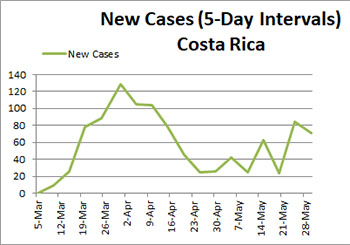 The better numbers are apparent in the lower incidence of cases, death rates (both as a percentage of cases and per million population) and higher recovery rates versus neighbors and key countries about the world.
The better numbers are apparent in the lower incidence of cases, death rates (both as a percentage of cases and per million population) and higher recovery rates versus neighbors and key countries about the world.
Have we peaked? I hope to God so. Here's another way to look at it: new cases. That's depicted in the table to the right with 5-day totals of new infections as the organizer.
Also, another press report noted that, as of May 15, there had been more Tico deaths by COVID-19 in the U.S. (20) than in Costa Rica (10). There are some 18,270 Ticos living in New Jersey alone who are near the U.S. epicenter for the disease (New York City).
¡Pura Vida!
TOP
Travel Quote of the Month

¡A Cachete Inflado! (See What's-in-a-Word Section for the meaning of the saying A Cachete Inflado)
TOP
GGC Bookshelf
Now is the perfect time to cuddle up with a couple or three of the books on the GGC Bookshelf below. It's a good way to wait out the quarantine! Currently there are 15 selections to choose from.
The latest book to hit the market and the GGC Bookshelf is by one of our associates from the San José Writers Group, Helen Dunne Frame. Its title is Expat Tales and includes some interesting real stories about people who have moved here successfully and maybe some things to know about what not to do. Check out the cover on the list below (#11) and click on the "Read More" button to review a synopsis of the work and to order.

GGC Publications is the parent organization that publishes the Golden Gringo Chronicles as well as my personal titles of a number of books and paraphernalia related to the Chronicles and Costa Rica. The GGC Bookshelf also includes works from a number of other authors that belong to various writers groups based in Costa Rica including the Quepos-Manuel Antonio Writers Group.
Here's the current GGC Bookshelf offering; follow the "Read More" link below each book to read a more detailed description of the book.
All of the above books are available on Amazon.com and the "Read More" links above will lead you to them. You can find more detail on all of them on our GGC Publications Page.
GGC Products Store
GGC Publications also offers some accessories and paraphernalia related to the Chronicles and with Costa Rican themes, to wit:
T-Shirts:

a. Golden Gringo Chronicles with Logo,
b. Official Golden Gringo with Monkey on Banana Hammock,
c. ¡Quepo en Quepos! ("I Fit In Quepos!") with Photo of Quepos,
d. Wanna Monkey Around? - Come on Down! (shown) with Photo of White Faced Monkey,
e. It's OK to be Slothful with photo of Three-Toed Sloth.
The t-shirts are available in several themes, colors, styles and sizes. See them all HERE.
Coffee Mugs:
a. Golden Gringo, b. Wanna Monkey Around?, c. It's OK to be Slothful
See them all HERE:
What's life without a great cup of Costa Rican coffee? And it tastes even better in a Golden Gringo Chronicles mug!
To see ALL the products available in the Golden Gringo Store go here: GGC Store.
¡Solo Bueno!
What's-in-a-Word
"Tell me and I forget; teach me and I remember; involve me and I learn"
– Benjamin Franklin
Answer to Que Es Eso?
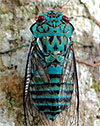 This is not a fly, it's an Emerald Cicada (zammara smaragdula). Cicadas are common in tropical regions and can be heard particularly strong in the hottest part of the day. There are over 3,000 species and can vary from 0.75 to 2.25 in. or 2 to 5.5 cm.
This is not a fly, it's an Emerald Cicada (zammara smaragdula). Cicadas are common in tropical regions and can be heard particularly strong in the hottest part of the day. There are over 3,000 species and can vary from 0.75 to 2.25 in. or 2 to 5.5 cm.
The cicada sings by contracting the internal tymbal muscles (that's the striped portion at it's bottom). This causes the membranes to buckle inward, producing a distinct sound. In addition to attracting a mate, the loud noise actually repels birds. You can listen to one sing here: https://www.youtube.com/watch?v=R-nxPvIQHf0
¡A Cachete Inflado!
A cah-chet-tay een-flah-do. Literally translated this means "an inflated cheek." In local slang parlance ("pacheco") this is sometimes used in response to how are you ("¿Como estas?"), or how's it going ("¿Como le va?"). The implication is that an inflated cheek means you're well-fed and in good spirits.
¡Pura Vida!
TOP
ROMEO Corner
(Retired Old Men Eating Out)
Restaurant: Coffee Stop Bistro Café, Quepos
Location: Inside the mini-mall across from the bus station.
Hours: Breakfast, Lunch and Dinner
Parking: Street Only.
Contacts: Facebook, Tel: 2777-9494
Reviewing ROMEOS: Bob N., Jessie P., Lee W.
To Review Our Rating System Go Here: R.O.M.E.O. Rating System
 Coffee Stop is a fairly new restaurant in Quepos (less than a year old) and bills itself as a gourmet cafeteria. We saw no reason to argue with that description. The first impression that the place was planned and laid out by a professional. The lighting is ample but not too bright as well as being artistic, the tables are simple but functional and, best of all, some of the tables are cornered in deep-cushioned seating. Even the single plastic-form chairs have a cushioned seat; a somewhat abnormal (and welcome) practice in this region. It's also one of the few restaurants in the area that is air conditioned.
Coffee Stop is a fairly new restaurant in Quepos (less than a year old) and bills itself as a gourmet cafeteria. We saw no reason to argue with that description. The first impression that the place was planned and laid out by a professional. The lighting is ample but not too bright as well as being artistic, the tables are simple but functional and, best of all, some of the tables are cornered in deep-cushioned seating. Even the single plastic-form chairs have a cushioned seat; a somewhat abnormal (and welcome) practice in this region. It's also one of the few restaurants in the area that is air conditioned.
The staff is clothed in simple black uniforms that add to the semi-formality of the place. The two-sided, laminated menu has a nice selection of lunch and light-dinner offerings. The overall appearance of the place at once gives a feeling of comfort and relaxation.
The ROMEOs gave Coffee Stop a 4.7/5.0 sloth rating for ambiance.
GG had sampled the Coffee Stop cheeseburger on a previous visit and found it to be the best (big, fresh and juicy) burger in the area, bar none. On this visit another ROMEO rated it the same level. The burger is served with a stand of steak fries and two dipping sauces.
Trying to go light on lunch for a change, GG selected a green salad with ham strips bathed in a Caribbean vinaigrette with spices. It was fresh and of an excellent flavor. All three ROMEOs accompanied their lunch with a batido naturale (e.g. mango, maracuya).
A third ROMEO had the Tuesday lunch special of pasta bolognese. All three of the ROMEOs gave our maximum rating to the quality of food of 5.0/5.0 sloths. |
 |
.jpg) .8 .8 |
| $$$$ |
Value Index= 120 |
We were served by a very pleasant and helpful young lady who made sure to check with us in the middle of the meal as to our pleasure and concerns. Asking in this way is not an all-together common practice in these parts and is another sign of a professional restauranteer. The ROMEO composite score for service came in at 4.8/5.0 and gave an average rating for ambiance, food quality and service or 4.78/5.0.
The total cost of all three ROMEO lunches together came in at just over 19,600 colones or about $11.50 per person. Our composite rating for cost was 4.0/5.0. That yielded a Value Index of: 4.78/4.0x100=119 putting Coffee Spot in the top one third of our restaurant ratings for value in this area for value.
The ROMEOs can easily and heartily recommend Coffee Spot for quality food in a very pleasant atmosphere and which is convenient to downtown businesses.
¡Solo Bueno!
TOP
Opt-In Here to Receive Your Free Monthly Copy Of
The Golden Gringo Chronicles
The Golden Gringo Chronicles is a free newsletter that is non-political, non-commercial and, hopefully, informative and entertaining. By signing up you will receive an email each month around the first of the month giving you the links to the latest edition as well as to each individual feature and departmental section.
CLICK HERE TO SIGN-UP FOR THE GOLDEN GRINGO CHRONICLES
or Email me at gg@goldengringo.com, or use our Website at: www.goldengringo.com

Bob Normand, Editor & The Golden Gringo
Pura Vida!
To Contact GGC World Headquarters (yuk, yuk) to makecomments, suggest topics or criticize my bad jokes, just send an email to: gg@goldengringo.com.
Be pithy but kind; I'm sensitive.
Unsubscribe from the Golden Gringo Chronicles


 In the midst of the Coronavirus crisis there was one bright spot, at least for the President of the Republic. According to the University of Costa Rica's polling survey (CEIP-ECP - we don't have enough space to unravel that acronym), President Alvarado's approval rating skyrocketed in the last two months to 65%. That equals the highest rating for a president in the last seven presidents with the exception of the very early administration of Pacheco some 18 years ago.
In the midst of the Coronavirus crisis there was one bright spot, at least for the President of the Republic. According to the University of Costa Rica's polling survey (CEIP-ECP - we don't have enough space to unravel that acronym), President Alvarado's approval rating skyrocketed in the last two months to 65%. That equals the highest rating for a president in the last seven presidents with the exception of the very early administration of Pacheco some 18 years ago.

 In another example, 40 Costa Ricans were recently repatriated from being stranded in Ecuador. Over half of these (26) had waited several weeks in Guayaquil, the epicenter of the disease for Ecuador, until the repatriation flight could be arranged. When they were tested on arrival at the Costa Rican airport four of them were found to be infected and were immediately isolated and treated. All others were assigned to a 14-day self-quarantine. There have been a total of 13 repatriation flights that have landed at Juan Santamaria Airport since the shutdown began and they have yielded a total of 15 new COVID positives.
In another example, 40 Costa Ricans were recently repatriated from being stranded in Ecuador. Over half of these (26) had waited several weeks in Guayaquil, the epicenter of the disease for Ecuador, until the repatriation flight could be arranged. When they were tested on arrival at the Costa Rican airport four of them were found to be infected and were immediately isolated and treated. All others were assigned to a 14-day self-quarantine. There have been a total of 13 repatriation flights that have landed at Juan Santamaria Airport since the shutdown began and they have yielded a total of 15 new COVID positives. In this regard, Costa Rica recently intercepted a large cattle truck containing some 69 Nicaraguans trying to cross over the border near Los Chiles (North Central CR) at a largely unattended area often labeled a "blind spot". These poor people were stuffed into a small, Nicaragua-registered cattle truck which hoped to evade the patrols (see photo left). No information was released on the state of health of these people but I suspect they will all be tested for COVID.
In this regard, Costa Rica recently intercepted a large cattle truck containing some 69 Nicaraguans trying to cross over the border near Los Chiles (North Central CR) at a largely unattended area often labeled a "blind spot". These poor people were stuffed into a small, Nicaragua-registered cattle truck which hoped to evade the patrols (see photo left). No information was released on the state of health of these people but I suspect they will all be tested for COVID. 

 Current President Carlos Alvarado recently officiated at a law signing ceremony making December 1 a new holiday; Army Abolition Day. It celebrates the day in 1948, after the conclusion of the civil war, when the constitution of the Second Republic was approved and the Army was abolished. On that day, then President José Figueres Ferrer symbolized the act by smashing down part of the wall with a sledge hammer at the military barracks in San José.
Current President Carlos Alvarado recently officiated at a law signing ceremony making December 1 a new holiday; Army Abolition Day. It celebrates the day in 1948, after the conclusion of the civil war, when the constitution of the Second Republic was approved and the Army was abolished. On that day, then President José Figueres Ferrer symbolized the act by smashing down part of the wall with a sledge hammer at the military barracks in San José.
 Proponents point out the many, many uses of hemp shown in the chart to the right above. "Its seeds and flowers are used in health foods, organic body care, and other nutraceuticals. The fibers and stalks are used in hemp clothing, construction materials, paper, biofuel, plastic composites, and more." Hemp is also an attractive rotation crop for farmers, preventing erosion and enriching the soil in certain nutrients.
Proponents point out the many, many uses of hemp shown in the chart to the right above. "Its seeds and flowers are used in health foods, organic body care, and other nutraceuticals. The fibers and stalks are used in hemp clothing, construction materials, paper, biofuel, plastic composites, and more." Hemp is also an attractive rotation crop for farmers, preventing erosion and enriching the soil in certain nutrients. One would not expect pressure to increase prices during a period when production and demand are artificially suppressed, like now. Recent reports on inflation rate confirm that, and although relatively minor, an actual deflation rate was achieved in the early months of this year.
One would not expect pressure to increase prices during a period when production and demand are artificially suppressed, like now. Recent reports on inflation rate confirm that, and although relatively minor, an actual deflation rate was achieved in the early months of this year. Roche is a large (+$60 billion with nearly 20% profit margin) Swiss Pharmaceutical company that has support for its Americas operation based in Escazu Village near San Jose. This year they plan to add another 370 employees bringing their total here to 700. The expansion in Services & Solutions will add a Human Resources department and later Finance and Procurement.
Roche is a large (+$60 billion with nearly 20% profit margin) Swiss Pharmaceutical company that has support for its Americas operation based in Escazu Village near San Jose. This year they plan to add another 370 employees bringing their total here to 700. The expansion in Services & Solutions will add a Human Resources department and later Finance and Procurement.  Readers have probably heard and seen reports of the major effort by the U.S. Government and major manufacturers to convert some manufacturing facilities to the production of ventilators for COVID-19 patients, used particularly for those in the most critical condition. Ford Motor Company was one of those manufacturers who undertook the conversion of some of their plant. In turn they recently awarded a sub-contact to produce 100,000 pressure switches to Microtechnologies of Costa Rica.
Readers have probably heard and seen reports of the major effort by the U.S. Government and major manufacturers to convert some manufacturing facilities to the production of ventilators for COVID-19 patients, used particularly for those in the most critical condition. Ford Motor Company was one of those manufacturers who undertook the conversion of some of their plant. In turn they recently awarded a sub-contact to produce 100,000 pressure switches to Microtechnologies of Costa Rica. 

 Forty Ticos on tour of Ecuador were recently caught there in the transportation freeze caused by the Coronavirus; they were stranded for over a month. Of these, some 26 had been staying in the city of Guayaquil which happens to be the epicenter for the disease in Ecuador (stats as of May 30 for Ecuador were: cases=38,571, deaths=3,334, recovered=19,190). The flying time from Quito to San José is only about two hours but the group of 26 from Quayaquil had to endure an eight hour bus ride from Quayaquil to the capital city airport in Quito before the flight.
Forty Ticos on tour of Ecuador were recently caught there in the transportation freeze caused by the Coronavirus; they were stranded for over a month. Of these, some 26 had been staying in the city of Guayaquil which happens to be the epicenter for the disease in Ecuador (stats as of May 30 for Ecuador were: cases=38,571, deaths=3,334, recovered=19,190). The flying time from Quito to San José is only about two hours but the group of 26 from Quayaquil had to endure an eight hour bus ride from Quayaquil to the capital city airport in Quito before the flight. We mentioned
We mentioned 
 #opnicaragua. As if dealing with the COVID-19 virus wasn't enough, at least one internet based group has emerged to do trouble to various government agencies and critical businesses around the world, including those in Nicaragua. The group is called "Anonymous" and is described as "...a decentralized international hacktivist
#opnicaragua. As if dealing with the COVID-19 virus wasn't enough, at least one internet based group has emerged to do trouble to various government agencies and critical businesses around the world, including those in Nicaragua. The group is called "Anonymous" and is described as "...a decentralized international hacktivist 





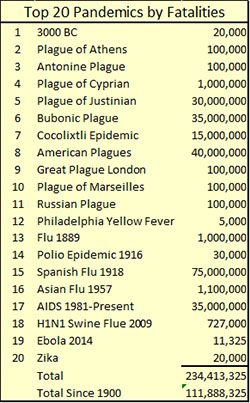

 The space below was intended for a GGU article (Golden Gringo University - a lower institution of learning) about obtaining naturalized citizenship in Costa Rica, a process GG has been pursuing for some time. I've gotten approval (three times now) and was awaiting an appointment for a photo to get a new cédula by the appropriate government bureau but the onset of the Coronavirus shortened staff and operations at government offices. The national emergency has slowed the process of getting new approvals from government agencies on just about anything and everything.
The space below was intended for a GGU article (Golden Gringo University - a lower institution of learning) about obtaining naturalized citizenship in Costa Rica, a process GG has been pursuing for some time. I've gotten approval (three times now) and was awaiting an appointment for a photo to get a new cédula by the appropriate government bureau but the onset of the Coronavirus shortened staff and operations at government offices. The national emergency has slowed the process of getting new approvals from government agencies on just about anything and everything.  The isthmus, now known as Central America, consists of seven countries, alphabetically: Belize, Costa Rica, El Salvador, Guatemala, Honduras, Nicaragua and Panama (or, going north to south: Belize, Guatemala, Honduras, El Salvador, Nicaragua, Costa Rica and Panama). Together they represent a total population of just under 50 million people.
The isthmus, now known as Central America, consists of seven countries, alphabetically: Belize, Costa Rica, El Salvador, Guatemala, Honduras, Nicaragua and Panama (or, going north to south: Belize, Guatemala, Honduras, El Salvador, Nicaragua, Costa Rica and Panama). Together they represent a total population of just under 50 million people.  The science and practice of archaeology has slowly uncovered many different examples of Amerindian culture all over the Americas. One of the more interesting ones found in Costa Rica is the archaeological remnants of a people that populated an area near the modern town of Liberia in the northwestern corner of Costa Rica. The area is less than 90 km south of the Nicaragua border and dead center on the migratory route south.
The science and practice of archaeology has slowly uncovered many different examples of Amerindian culture all over the Americas. One of the more interesting ones found in Costa Rica is the archaeological remnants of a people that populated an area near the modern town of Liberia in the northwestern corner of Costa Rica. The area is less than 90 km south of the Nicaragua border and dead center on the migratory route south. 

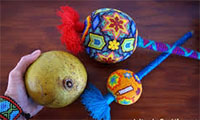




















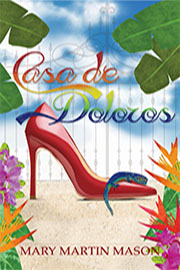




 This is not a fly, it's an Emerald Cicada (zammara smaragdula). Cicadas are common in tropical regions and can be heard particularly strong in the hottest part of the day. There are over 3,000 species and can vary from 0.75 to 2.25 in. or 2 to 5.5 cm.
This is not a fly, it's an Emerald Cicada (zammara smaragdula). Cicadas are common in tropical regions and can be heard particularly strong in the hottest part of the day. There are over 3,000 species and can vary from 0.75 to 2.25 in. or 2 to 5.5 cm.  Coffee Stop is a fairly new restaurant in Quepos (less than a year old) and bills itself as a gourmet cafeteria. We saw no reason to argue with that description. The first impression that the place was planned and laid out by a professional. The lighting is ample but not too bright as well as being artistic, the tables are simple but functional and, best of all, some of the tables are cornered in deep-cushioned seating. Even the single plastic-form chairs have a cushioned seat; a somewhat abnormal (and welcome) practice in this region. It's also one of the few restaurants in the area that is air conditioned.
Coffee Stop is a fairly new restaurant in Quepos (less than a year old) and bills itself as a gourmet cafeteria. We saw no reason to argue with that description. The first impression that the place was planned and laid out by a professional. The lighting is ample but not too bright as well as being artistic, the tables are simple but functional and, best of all, some of the tables are cornered in deep-cushioned seating. Even the single plastic-form chairs have a cushioned seat; a somewhat abnormal (and welcome) practice in this region. It's also one of the few restaurants in the area that is air conditioned.
